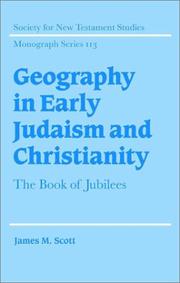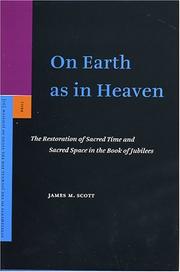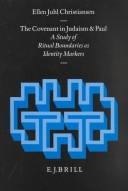| Listing 11 - 14 of 14 | << page >> |
Sort by
|

ISBN: 052180812X 0521020689 0511549970 9780521808125 Year: 2002 Volume: 113 Publisher: Cambridge : Cambridge University Press,
Abstract | Keywords | Export | Availability | Bookmark
 Loading...
Loading...Choose an application
- Reference Manager
- EndNote
- RefWorks (Direct export to RefWorks)
In this 2002 book, James M. Scott focuses on a particular Old Testament pseudepigraphon - the Book of Jubilees, the revelation of an angel to Moses announcing the expectation of a messiah from Judah. He traces the appropriation of the Book of Jubilees in early Christian sources from the New Testament to Hippolytus and beyond, and more specifically focuses on the reception of Jubilees 8-9, an expansion of the so-called Table of Nations in Genesis 10 (1 Chronicles 1). The book takes an interdisciplinary approach based on detailed analysis of primary sources, much of which is seldom considered by New Testament scholars, and explores the neglected topic of ancient geographical conceptions. By studying geographical aspects of the work, Dr Scott is able to relate Jubilees to both Old and New Testament traditions, bringing important new insights into Christian concepts of annunciation.
229*202 --- 913.3 --- Christian literature, Early --- -Geography, Ancient --- Geography, Ancient --- -Ancient geography --- Geography --- Early Christian literature --- Patristic literature --- 229*202 Boek der Jubileeën --- Boek der Jubileeën --- Aardrijkskunde van Palestina --- History and criticism --- Maps --- Ancient geography --- Atlases, Historical --- Historical atlases --- Early maps --- Bible. --- Book of Jubilees VIII-IX --- Table of nations --- Geography. --- Criticism, interpretation, etc. --- History --- Geography, Ancient. --- History and criticism. --- Geography [Ancient ] --- Cartes --- Christian literature [Early ] --- Book of Jubilees VIII-IX - Geography. --- Bible. - O.T. - Genesis X - Geography. --- Book of Jubilees VIII-IX - Criticism, interpretation, etc. - History - To 1500. --- Arts and Humanities --- Religion --- Geography, Ancient - Maps --- Christian literature, Early - History and criticism.

ISBN: 9004137963 9786610859481 1429426969 9047405110 1280859482 1433704536 9781429426961 9789004137967 9781433704536 Year: 2005 Volume: 91 Publisher: Leiden Boston Brill
Abstract | Keywords | Export | Availability | Bookmark
 Loading...
Loading...Choose an application
- Reference Manager
- EndNote
- RefWorks (Direct export to RefWorks)
This volume deals with the chronological and spatial conceptions underlying the Book of Jubilees, a Jewish apocalyptic writing of the mid-second century BCE, and shows how in these respects Jubilees forms a bridge between the earlier Enochic tradition and the later Qumran sectarian writings. The book argues essentially that for Jubilees, the consummation of the ages will effect the restoration of sacred space and sacred time, so that all things correspond to God's original will for the creation on earth as in heaven. This book has important implications not only for the study of Jubilees itself and other Jewish writings of the Second Temple period, but also for research on early Christian chiliasm.
Calendar [Hebrew] --- Calendar [Jewish ] --- Calendrier hébreu --- Calendrier juif --- Chronologie [Joodse ] --- Chronologie hébraique --- Chronologie juive --- Chronology [Hebrew] --- Chronology [Jewish] --- Hebreeuwse chronologie --- Hebreeuwse kalender --- Hebrew chronology --- Heilige plaatsen --- Holy places --- Jewish calendar --- Jewish chronology --- Joodse chronologie --- Joodse kalender --- Kalender [Hebreeuwse ] --- Kalender [Joodse ] --- Lieux sacrés --- Plaatsen [Heilige ] --- Places [Sacred ] --- Sacred places --- Sacred space --- Sacred spaces --- Space [Sacred ] --- Spaces [Sacred ] --- 229*202 --- Boek der Jubileeën --- 229*202 Boek der Jubileeën --- Calendrier hébraïque --- Calendrier israélite --- Hebrew calendar --- Juifs -- Calendrier --- Time --- Hours (Time) --- Geodetic astronomy --- Nautical astronomy --- Horology --- Places, Sacred --- Sacred sites --- Sites, Sacred --- Space, Sacred --- Holy, The --- Religion and geography --- Chronology, Jewish --- Chronology --- Jews --- Calendar, Hebrew --- Calendar, Jewish --- Calendar --- Religious aspects&delete& --- Judaism --- History --- Book of Jubilees --- Bible. --- Little Genesis --- Jubilees --- Livre des Jubilés --- Petite Genèse --- Buch der Jubiläen --- Kleine Genesis --- Liber Jubilaeorum --- Parva Genesis --- Jubiläenbuch --- Sefer ha-Yovlim --- Criticism, interpretation, etc. --- Palestine --- In Judaism. --- Criticism, interpretation, etc --- Religious aspects --- Jewish calendar. --- Jewish chronology. --- Sacred space. --- Judaism.

ISBN: 9004103333 9004332804 9789004103337 Year: 1995 Volume: 27 Publisher: Leiden ; New York : E.J. Brill,
Abstract | Keywords | Export | Availability | Bookmark
 Loading...
Loading...Choose an application
- Reference Manager
- EndNote
- RefWorks (Direct export to RefWorks)
The Covenant in Judaism and Paul deals with biblical and intertestamental uses of covenant and related rituals, challenging the view that baptism replaces circumcision, since baptism is entry into the new covenant, and showing that ritual boundaries are replaced or redefined since identity has changed. The investigation uses social categories, “identity” as a term that offers an explanation for a group's selfunderstanding and “boundary” as a term for entry rite of affirmation marker. Part A looks at the Old Testament background to aspects of the covenant. Part B examines covenant identity and rituals in Palestinian Judaism as featured in Jubilees, the Temple Scroll, the Damascus Document, and the Community Rule. It includes a brief analysis of the baptism administered by John the Baptist. Part C analyses Paul's views on covenant, circumcision, and baptism against this background.
Covenant theology --- Alliance (Théologie) --- Biblical teaching --- Enseignement biblique --- Bible. --- Book of Jubilees --- Dead Sea scrolls --- Theology. --- Criticism, interpretation, etc. --- Criticism, interpretation, etc.. --- 227.08 --- 229*202 --- Covenant of grace --- Covenant of works --- Covenants (Theology) --- Federal theology --- Theology, Covenant --- Theology, Federal --- Covenants --- Theology, Doctrinal --- Paulinische theologie --- Boek der Jubileeën --- Religious aspects --- Congregational churches --- Presbyterian Church --- Puritans --- Reformed Church --- Theses --- 229*202 Boek der Jubileeën --- 227.08 Paulinische theologie --- Alliance (Théologie) --- Dead Sea scrolls. --- Jerusalem scrolls --- ʻAin Fashka scrolls --- Jericho scrolls --- Scrolls, Dead Sea --- Qumrân scrolls --- Rękopisy z Qumran --- Shikai bunsho --- Megilot Midbar Yehudah --- Dodezee-rollen --- Kumránské rukopisy --- Documentos de Qumrán --- Textos de Qumrán --- Rollos del Mar Muerto --- Manuscritos del Mar Muerto --- Manuscrits de la mer Morte --- Dödahavsrullarna --- Kumranin kirjoitukset --- Kuolleenmeren kirjoitukset --- Qumranhandskrifterna --- Qumranin kirjoitukset --- Qumran Caves scrolls --- Little Genesis --- Jubilees --- Livre des Jubilés --- Petite Genèse --- Buch der Jubiläen --- Kleine Genesis --- Liber Jubilaeorum --- Parva Genesis --- Jubiläenbuch --- Sefer ha-Yovlim --- Antico Testamento --- Hebrew Bible --- Hebrew Scriptures --- Kitve-ḳodesh --- Miḳra --- Old Testament --- Palaia Diathēkē --- Pentateuch, Prophets, and Hagiographa --- Sean-Tiomna --- Stary Testament --- Tanakh --- Tawrāt --- Torah, Neviʼim, Ketuvim --- Torah, Neviʼim u-Khetuvim --- Velho Testamento --- Epistles of Paul --- Paul, Epistles of --- Paul Sŏsin --- Pauline epistles --- Risālat al-Qiddīs Būlus al-rasūl al-thāniyah ilá Tīmūthīʼūs --- Covenant theology - Biblical teaching. --- Covenant theology. --- Christian theology --- Theology, Christian --- Christianity --- Religion --- Book of Jubilees. --- Palaia Diathēk
Book
ISBN: 9789004281059 9789004281653 9004281657 9004281053 1322515085 Year: 2014 Volume: 168 Publisher: Leiden Boston
Abstract | Keywords | Export | Availability | Bookmark
 Loading...
Loading...Choose an application
- Reference Manager
- EndNote
- RefWorks (Direct export to RefWorks)
This study examines the relationship between time and history in Second Temple literature. Numerous sources from that period express a belief that Jewish history began with an act of covenant formation and proceeded in linear fashion until the exile, an unprecedented event which severed the present from the past. The authors of Ben Sira, Jubilees , the Animal Apocalypse , and 4 Ezra responded to this theological challenge by claiming instead that Jewish history began at creation. Between creation and redemption, history unfolds as a series of static, repeating patterns that simultaneously account for the disappointments of the Second Temple period and confirm the eternal nature of the covenant. As iterations of timeless, cyclical patterns, the difficult post-exilic present and the glorious redemption of the future emerge as familiar, unremarkable, and inevitable historical developments.
223.7 --- 229*202 --- 229*209 --- 222.7 --- Wijsheid. Wijsheid van Jesus Sirach (Ecclesiasticus) --- Boek der Jubileeën --- I Henoch (Ethiopische Henoch) --- Kronieken. Ezra. Nehemia --- Bible. --- Apocrypha --- 229*209 I Henoch (Ethiopische Henoch) --- 229*202 Boek der Jubileeën --- Apocryphal books (Old Testament) --- Judaism --- Time --- Hellenistic Judaism --- Judaism, Hellenistic --- Criticism, interpretation, etc. --- History --- Religious aspects --- Judaism. --- History. --- History and criticism --- Ben Sira (Book of the Apocrypha) --- Book of Ben Sira (Book of the Apocrypha) --- Book of Sirach (Book of the Apocrypha) --- Ecclesiasticus (Book of the Apocrypha) --- Ḥokhmat Shimʻon ben Sira (Book of the Apocrypha) --- Ḥokhmat Yehoshuʻa ben Sira (Book of the Apocrypha) --- Jesus Sirach (Book of the Apocrypha) --- Sefer Ben Sira (Book of the Apocrypha) --- Sefer Ḥokhmat Yehoshuʻa ben Sira (Book of the Apocrypha) --- Sirach (Book of the Apocrypha) --- Sirachbuch (Book of the Apocrypha) --- Wisdom of Ben Sira (Book of the Apocrypha) --- Wisdom of Jesus the Son of Sirach (Book of the Apocrypha) --- Wisdom of Sirach (Book of the Apocrypha) --- Words of Simeon ben Jeshua (Book of the Apocrypha)
| Listing 11 - 14 of 14 | << page >> |
Sort by
|

 Search
Search Feedback
Feedback About
About Help
Help News
News